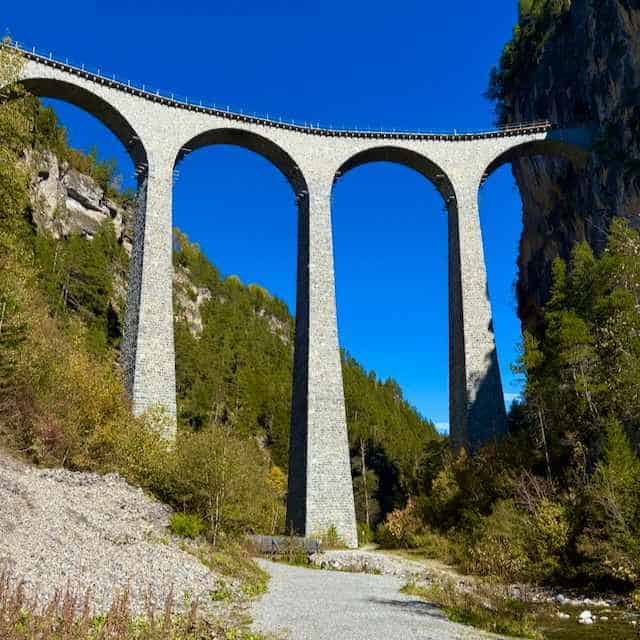
Many years ago, I was in St Moritz on a work trip. To get there, I took the narrow-gauge Bernina Express from Chur. Gorgeous views all the way, but that’s nothing special in Switzerland; almost everywhere is gorgeous in this little country. (And yes, it is little – about half the size of Scotland.)

What I couldn’t see from the train, however, was the engineering wonder that is the Landwasser Viaduct. So when I was in Liechtenstein last week, and realised it was only a one-hour drive away, well… why not?
Driving from Vaduz via Chur, I arrive at the carpark at the start of the trails. From there, you can walk in different directions to see the viaduct from various angles. I choose the way to the Landwasserviaduktaussichtspunkt (Landwasser Viaduct viewpoint), a 15-minute walk.
It’s a nice wander in the early autumn landscape…

…but I’m here for the viaduct – and the train.
Before I know it, I hear a roar above me. I look up and to the left, and soon spot a red train crossing a railway bridge up high. Is this the famed Landwasser Viaduct already?

It is not. This is the Schmittnertobel Viaduct, not as famous, but an equally striking high bridge along the same line, spanning a deep gorge. Schmittnerobel is often overlooked, but railway enthusiasts adore it. Get up close, and you’ll have similar photo opportunities and hardly another soul about.
Then, a few hundred metres on, I come to a clearing with a kiosk and a picnic area to the side – and the massive Landwasser Viaduct in front.

All fired up, ready for your barbecue
What Makes the Landwasser Viaduct So Special?
This 65-metre-high railway bridge spans across 136 metres of the Landwassertal (Landwasser Valley), on six symmetrical limestone arches.
It is a major feat of engineering, especially considering it was built 123 years ago, without modern scaffolding. And today, more than a century later, it is still in active use. Preserved legacy in motion.
What sets Landwasser apart from the other tall viaducts along the line, is the way it loops dramatically into a tunnel carved directly into the sheer cliff face. That is one jaw-dropping visual seen from down in the valley here.
The stone structure, with the graceful curve and daring cliffside tunnel, is part of the Rhaetian Railway. It is so extraordinary it was added to UNESCO’s World Heritage list in 2008.
Graubünden
But beyond this architectural masterpiece lies a region rich in culture, language, and hidden delights waiting to be explored.
The Landwasser Viaduct is more than a bridge, you see. It’s a symbol of alpine heritage, a living piece of history, and a window into the multilingual soul of Switzerland. Seeing the red Rhaetian Railway train sweep across this triumph of design, against a backdrop of towering peaks and ancient language, well, it’s simply unforgettable.
At the picnic spot by the viewpoint, I notice the writing on the tent. It is in Rhaeto-Romansch! Not often you see that.

Parc Ela – iql pi grond parc natural dalla Svizra = Parc Ela – the largest natural park in Switzerland
Rhaeto-Romansch
Odd name, no?
Rhaetian refers to a group of Alpine tribes that lived in the border area between Italy, Austria and Switzerland in ancient times. This was the Roman province of Raetia, and the inhabitants spoke the Rhaetic language.
Modern Rhaeto-Romansch on the other hand, evolved from Latin, the language of the conquering Roman soldiers and settlers, and preserved through the millennia through education, signage, literature, and media.
So if the languages are not related, why such similar names? Well, in both cases, Rhaeto comes from the region Raetia. There is a geographical and historical connection, but not a linguistic one.
Today, ca 45,000 people speak Rhaeto-Romansch, and they live here in Graubünden (Grisons), one of the 26 cantons (provinces) that make up the Swiss confederation. That means only 0.5% of the population speaks Rhaeto-Romansh, but it is still one of the four official languages of Switzerland.
It’s more than just a language, this. Rhaeto-Romansch is a living link to the region’s history, used in traditional festivals, in local governance, and even Swiss federal communication. Every citizen has the right to have public communication in their own language. That’s proper democracy for ya.
Here in Graubünden, you might hear locals switch seamlessly between Rhaeto-Romansh, German, Italian, and even French, like an echo of Switzerland’s unique multicultural fabric. Switzerland’s name in the four languages:
- Rhaeto-Romansch: Svizra
- Italian: Svizzera
- French: La Suisse
- German: Die Schweiz
- And bonus, Swiss German: Schwiiz

Looks elegant, doesn’t it – all symmetrical and curvy.
Rhaetian Railway practicals
Getting there
- By train: Take the Rhaetian Railway to the closest station, Filisur. From there, a footpath leads to the Landwasser Viewpoint (ca 25 min). The path is accessible in most seasons. Fantastic views of trains crossing the viaduct.
- By car: A 45-minute drive from Chur via A13 and Route 3. There’s a car park at Filisur train station, and one near the trailhead which I used. From there, the viewpoint Landwasserviaduktaussichtspunkt is a short walk away. (Also, don’t you just love German compounded words…)
Ways to experience the Landwasser Viaduct
On it: Take the Glacier Express or the Bernina Express – iconic panoramic trains that cross the viaduct slowly, with stunning alpine views any which way you turn.
Below it: Hike to the viewpoint for a perfect, elevated angle of the viaduct. Best photo light in the early morning or late afternoon.
Bahnmuseum Albula: The railway museum in Bergün, ca 10 minutes away by car (or train), has interactive exhibits on the history and construction of the Albula line, including models of the viaducts and tunnels.
Tips
- Spring and autumn is great for hiking and photography, and winter gives you that snowy magic. Trains run year-round, twice every hour.
- Don’t miss the Schmittnertobel Viaduct.
- Remember that mountain weather changes fast. Use good shoes and layers of clothing.

Rhaetian Railway in the Albula/Bernina Landscapes is a UNESCO World Heritage site.
Here are more UNESCO World Heritage sites we have visited around the world.
Please visit:
Our Sponsor
